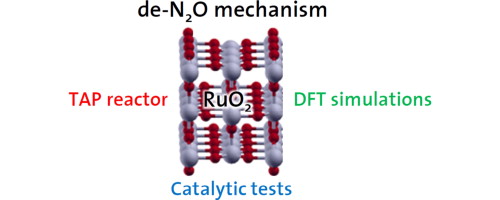The mechanisms of direct N2O decomposition and N2O reduction by H2 or NH3 on RuO2 has been studied by means of steady-state catalytic tests at ambient pressure, transient experiments in a temporal analysis of products (TAP) reactor, and density functional theory (DFT) simulations. Bulk RuO2 is very active for N2O decomposition into N2 and O2, achieving full conversion at 723 K. According to the DFT calculations, coordinatively unsaturated ruthenium (Rucus) sites are active for the decomposition and oxygen elimination from the surface is rate-limiting step. When pre-reducing RuO2 with H2, the de-N2O activity in the low-temperature region increases. This is attributed to the higher reactivity of surface oxygen vacancies created by H2 at bridge sites compared to Rucus sites. Co-feeding of hydrogen or ammonia with nitrous oxide strongly accelerates the rate of N2O elimination. TAP studies show that oxygen species formed upon N2O decomposition over RuO2 react with NH3 and H2 yielding N2, NO, N2O, and H2O. Both TAP experiments and DFT simulations show that the N-containing intermediates coming from ammonia adsorb much stronger on the catalyst surface than H-containing intermediates coming from hydrogen. This causes blockage of active sites for N2O decomposition by the former species, accounting for the higher efficiency of H2 as reductant for N2O. The presence of O2 in the feed cancels the reducing effect of H2 or NH3 due to the more favorable re-oxidation of reduced RuO2 by O2 compared to N2O.
